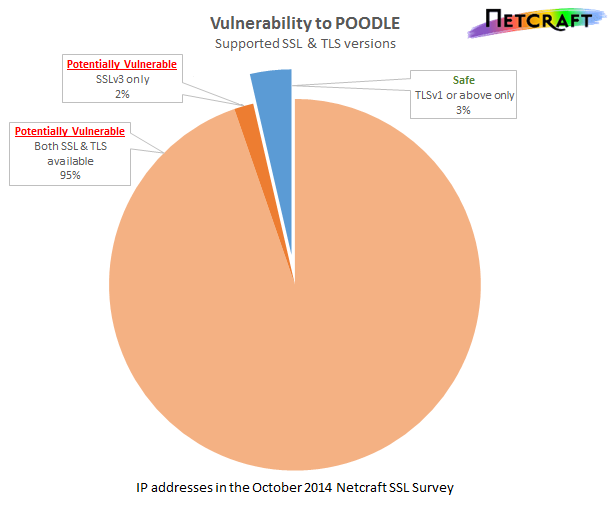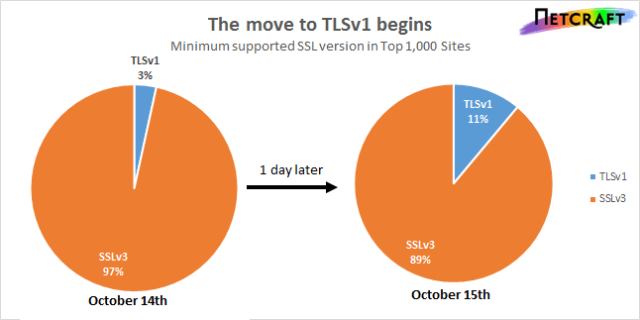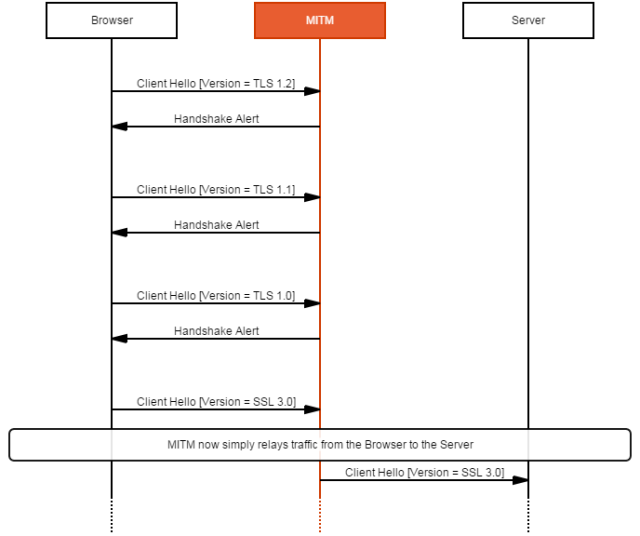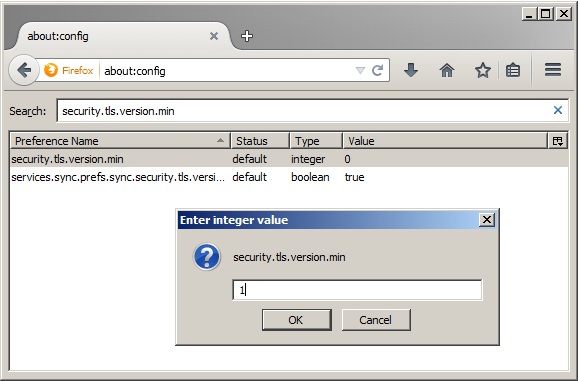Google’s POODLE affects oodles
97% of SSL web servers are likely to be vulnerable to POODLE, a vulnerability that can be exploited in version 3 of the SSL protocol. POODLE, in common with BEAST, allows a man-in-the-middle attacker to extract secrets from SSL sessions by forcing the victim’s browser into making many thousands of similar requests. As a result of the fallback behaviour in all major browsers, connections to web servers that support both SSL 3 and more modern versions of the protocol are also at risk.
The Secure Sockets Layer (SSL) protocol is used by millions of websites to protect confidential data in transit across the internet using strong cryptography. The protocol was designed by Netscape in the mid 1990s and was first released to the public as SSL 2 in February 1995. It was quickly replaced by SSL 3 in 1996 after serious security flaws were discovered. SSL 3 was replaced by the IETF-defined Transport Layer Security (TLS) version 1.0 in January 1999 with relatively few changes. Since TLS 1’s release, TLS 1.1 and TLS 1.2 have succeeded it and should be used in its place wherever possible.

POODLE’s bark may be worse than its bite
Unlike Heartbleed, POODLE can be used to attack client-server connections and is inherent to the protocol itself, rather than any one implementation such as OpenSSL or Microsoft’s SChannel. In order to exploit it, an attacker must modify the victim’s network traffic, know how the targeted secret information is structured (such as where a session cookie appears) and be able to force the victim into making a large number of requests.
Each SSL connection is split up into a number of chunks, known as SSL records. When using a block cipher, such as Triple DES in CBC mode, each block is mixed in with the next block and the record then padded to be a whole number of blocks long (8-bytes in the case of Triple DES). An attacker with network access can carefully manipulate the ordering of the cipher-blocks within a record to influence the decryption and exploit the padding oracle. If the attacker has been lucky (there’s a 1 in 256 chance), she will have matched the correct value for the padding length in her manipulated record and correctly guessed the value of a single byte of the secret. This can be repeated to reveal the entire targeted secret.
SSL 3’s padding is particularly easy to exploit as it relies on a single byte at the end of the padding, the padding length. Consequently an attacker must force the victim to make only 256×n requests for n bytes of secret to be revealed. TLS 1.0 changed this padding mechanism, requiring the padding bytes themselves to have a specific value making the attack far less likely to succeed.
The POODLE vulnerability makes session hijacking attacks against web applications reasonably feasible for a correctly-positioned attacker. For example, a typical 32-byte session cookie could be retrieved after eavesdropping just over 8,000 HTTPS requests using SSL 3. This could be achieved by tricking the victim into visiting a specially crafted web page which uses JavaScript to send the necessary requests. Use of SSL v3
Within the top 1,000 SSL sites, SSL 3 remained very widely supported yesterday, with 97% of SSL sites accepting an SSL 3 handshake. CitiBank and Bank of America both support SSL 3 exclusively and presumably are vulnerable.

A number of SSL sites have already reacted to this vulnerability by disabling support for SSL 3, including CloudFlare and LinkedIn. On Tuesday 14th, the most common configuration within the top 1,000 SSL sites was to support SSL 3.0 all the way through to TLS 1.2, with almost two-thirds of popular sites taking this approach. One day later, this remains the most popular configuration ; however, TLS 1.0 is now the minimum version for 11%.
Microsoft Internet Explorer 6 does not support TLS 1.0 or greater by default and may be the most notable victim of disabling SSL 3 internet-wide. Now 13 years old, IE6 was the default browser released with Windows Server 2003 and Windows XP in 2001 and will remain supported in Windows Server 2003 until July 2015. Despite its age and the end of Microsoft’s support for Windows XP, IE6 remains popular, accounting for more 3.8% of web visits worldwide, and 12.5% in China. This vulnerability may ring the death knell for IE6 and Windows XP.
However, unless SSL 3 is completely disabled on the server side, a client supporting SSL 3 may still be vulnerable even if the server supports more recent versions of TLS. An attacker can take advantage of browser fallback behaviour to force otherwise secure connections to use SSL 3 in place of TLS version 1 or above. SSL version negotiation
At the start of an SSL connection, servers and clients mutually agree upon a version of SSL/TLS to use for the remainder of the connection. The client’s first message to the server includes its maximum supported version of the protocol, the server then compares the client’s maximum version against its own maximum version to pick the highest mutually supported version.
While this mechanism protects against version downgrade attacks in theory, most browsers have an additional fallback mechanism that retries a connection attempt with successively lower version numbers until it succeeds in negotiating a connection or it reaches the lowest acceptable version. This additional fallback mechanism has proven necessary for practical interoperability with some TLS servers and corporate man-in-the-middle devices which, rather than gracefully downgrading when presented with a non-supported version of TLS, they instead terminate the connection prematurely.
An attacker with appropriate network access can exploit this behaviour to force a TLS connection to be downgraded by forging Handshake Alert messages. The browser will take the Handshake Alert message as a signal that the remote server (or some intermediate device) has version negotiation bugs and the browser will retry the connection with a lower maximum version in the initial Client Hello message.

Operation of a forced downgrade to SSL 3 against a modern browser.
The fallback mechanism was previously not a security issue as it never results in the use of a protocol version that neither the client nor server will accept. However, those with clients that have not yet been updated to disable support for SSL 3 are relying on the server to have disabled SSL 3. What remains is a chicken and egg problem, where modern clients support SSL 3 in order to retain support for legacy servers, and modern servers retain support for SSL 3 for legacy clients.
There is, however, a proposed solution in the form of an indicator (an SCSV) in the fallback connection to inform compatible servers that this connection is a fallback and to reject the connection unless the fallback was expected. Google Chrome and Google’s web sites already support this SCSV indicator.

|

|

|

|

|
TLS 1.2 | TLS 1.2 x 3 | TLS 1.2 | TLS 1.2 x 3 | TLS 1.2 |
| TLS 1.1 | TLS 1.1 | TLS 1.1 |
| TLS 1.0 | TLS 1.0 | TLS 1.0 | TLS 1.0 | TLS 1.0 |
| SSL 3.0 | SSL 3.0 | SSL 3.0 | SSL 3.0 | SSL 3.0 |
Comparison of browser fallback behaviour
We tested five major browsers with an attack based on the forged Handshake Alert method outlined above, and found that each browser has a variant of this fallback behaviour. Both Chrome and Opera try TLS 1.2 three times before trying to downgrade the maximum supported version, whereas the remainder immediately started downgrading. Curiously, Internet Explorer and Safari both skip TLS 1.1 and jump straight from TLS 1.2 to TLS 1.0. Mitigation
Mitigation can take many forms : the fallback SCSV, disabling SSL 3 fallback, disabling SSL 3 in the client side, disabling SSL 3 in the server side, and disabling CBC cipher suites in SSL version 3. Each solution has its own problems, but the current trend is to disable SSL 3 entirely.
Disabling only the CBC cipher suites in SSL 3 leaves system administrators with a dilemma : RC4 is the only other practical choice and it has its fair share of problems making it an undesirable alternative. The SCSV requires support from both clients and servers, so may take some time before it is widely deployed enough to mitigate this vulnerability ; it will also likely not be applied to legacy browsers such as IE 6.
Apache httpd can be configured to disable SSL 3 as follows : SSLProtocol +TLSv1 +TLSv1.1 +TLSv1.2 -SSLv2 -SSLv3 Microsoft IIS and nginx can also be configured to avoid negotiating SSL version 3.
Firefox can be configured to disable support for SSL 3 by altering security.tls.version.min from 0 (SSL 3) to 1 (TLS 1) in about:config.

Internet Explorer can also be configured to disable support using the Advanced tab in the Internet Options dialogue (found in the Control Panel). In a similar way, IE 6 users can also enable support for TLS 1.0.

Chrome can be configured to not use SSL 3 using a command line flag, —ssl-version-min=tls1. Site Report
You can check which SSL sites are still using SSL 3 using the Netcraft Site Report :
Netcraft site report
Voir en ligne : http://news.netcraft.com/archives/2...
 L’Imp’Rock Scénette (by @_daffyduke_)
Logiciel libre, rock’n roll et biochimie ...
L’Imp’Rock Scénette (by @_daffyduke_)
Logiciel libre, rock’n roll et biochimie ...